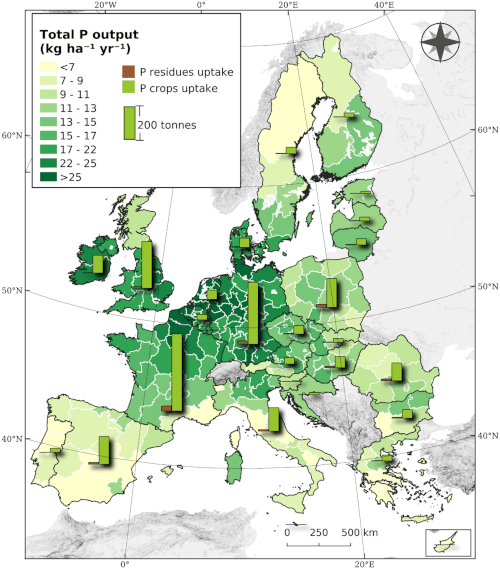Panagos, Panosa, Anna Muntwylera, Leonidas Liakosa, Pasquale Borrellib, Irene Biavettia, Mariia Bogonosc , and Emanuele Lugatoa. 2022. “Phosphorus Plant Removal from European Agricultural Land.” Journal of Consumer Protection and Food Safety, February. https://doi.org/10.1007/s00003-022-01363-3.^
a European Commission, Joint Research Centre (JRC), Ispra, Italy
b Dipartimento di Scienze della Terra e dell’Ambiente, Università degli Studi di Pavia, Pavia, Italy
c European Commission, Joint Research Centre (JRC), Seville, Spain
Phosphorus (P) is an important nutrient for all plant growth and it has become a critical and often imbalanced element in modern agriculture. A proper crop fertilization is crucial for production, farmer profits, and also for ensuring sustainable agriculture. The European Commission has published the Farm to Fork (F2F) Strategy in May 2020, in which the reduction of the use of fertilizers by at least 20% is among one of the main objectives. Therefore, it is important to look for the optimal use of P in order to reduce its pollution effects but also ensure future agricultural production and food security. It is essential to estimate the P budget with the best available data at the highest possible spatial resolution. In this study, we focused on estimating the P removal from soils by crop harvest and removal of crop residues. Specifically, we attempted to estimate the P removal by taking into account the production area and productivity rates of 37 crops for 220 regions in the European Union (EU) and the UK. To estimate the P removal by crops, we included the P concentrations in plant tissues (%), the crop humidity rates, the crop residues production, and the removal rates of the crop residues. The total P removal was about 2.55 million tonnes (Mt) (± 0.23 Mt), with crop harvesting having the larger contribution (ca. 94%) compared to the crop residues removal. A Monte-Carlo analysis estimated a ± 9% uncertainty. In addition, we performed a projection of P removal from agricultural fields in 2030. By providing this picture, we aim to improve the current P balances in the EU and explore the feasibility of F2F objectives.

Comments
comments powered by Disqus